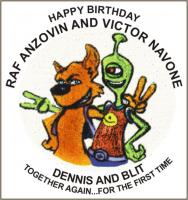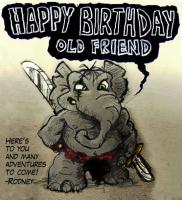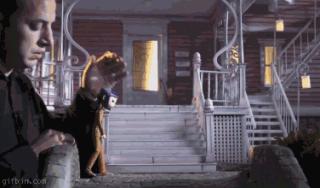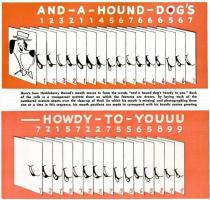-
Posts
21,630 -
Joined
-
Last visited
-
Days Won
114
Content Type
Profiles
Forums
Events
Everything posted by Rodney
-
Perk is a pretty energetic and innovative fellow. He even managed to sneak his way onto the cover of TaoA:M and the A:M CD. If I recall correctly it was way back in 2003. Dusan then went on to create 'Chicory and Coffee' among other things not in general circulation. 'Chicory and Coffee' was quite a hit on the festival circuit.
-
She's looking great Gerald. My focus fairly quickly went to her eyes (which is a good thing) and I think some refinement there will pay off for you. Adjusting the harsher contrast and black lines (perhaps layering over some additional color should help. Looking at the still image here pupils seem to me to be more animal like than human but that might be an effect of the angle of render? I believe you already know what I'm talking about here but I can circle/indicate more specific areas as necessary. If this were going to be maintained as a lower quality render I'd say most of these details won't be seen and so I'd suggest focusing on the over all shape of the hair... perhaps getting some more natural curvature into the hair. She reminds me of a lady I arrested that looked 45 years old but her ID revealed she was only 28. She had seen better days...
-
Hey, I forgot those two illustrious talents shared a day. Happy Birthday Victor and Raf! May your journeys to the birthdays of tomorrow all be smooth sailing.
-
I'm going to say he would. There is something about the fact that you've got all these characters from different 'worlds' that really appeals to me. I suppose keeping him mostly a puppet wouldn't prevent an episode or two where he transforms into another persona. If you make a reasonable story that explains the change I'd say people will follow along. I fully expect Gwen to get some transformer like armor and sword one of these days so why not Tech also? If you keep having fun with it I think others will too. You are doing a great job of leveraging the resources you have available to you. Just keep plussing it up a little each episode and that'll keep me hooked.
-
Happy Birthday Will! Here's to another year of quality splining! Added: Thought I'd draw Tar as a child... then ended up drawing an old friend of his... then fast forwarded to a fateful moment when that old friend drops in to visit Tar again...
-
'Perk' by Dusan Kastelic is now playing at the top of the forum. http://amfilms.hash.com/video/55/Perk
-
That worked out really well Dan!
-
Nice! I'm betting most people will think you've only faked the tapir.
-
Pretty slick John. If I'd have seen that out in the wild I would have guessed it was created with Flash or similar program. It makes me think of some of the opening sequences seen for cartoon shows these days. Nicely done.
-
In another topic we were talking about Pose Sliders and modifying models... Here's a animated sequence originally shared by Bill Alger through Google+ that demonstrates an equivalent process via Stop Motion. Just replace the Guy animating Coraline with the Pose Sliders. Either way the 'trick' isn't seen in the end product. (Click on the image to begin the GIF animation) Source: http://animationanomaly.com/page/3/
-
Here's a fun extract from an old Popular Mechanics write up on Hanna Barbera animation. You can read the whole article via Google Books. Link found via Jerry Beck over at Cartoon Brew. At the end of the article you can read the following from 51 years ago: The article discusses some of the cost saving methods Hanna Barbera was using at that time. Of course all these years later they can still apply to CG too.
-
It would help considerably if you could collect your project (Embed or Consolidate all important parts) and share it with us. Then we can see exactly what you are seeing and optimally resolve the problem. Without knowing more specifically, I see two approaches immediately available to you: 1. Pursue Surface Constraints 2. Use the Surface as the Path Constraint There are topics here in the forum on both of these but I'm not sure how easy they'll be to find. If someone doesn't have a reference handy I'll try to ferret it out. (Edit: Here someone else was pursuing info about Surface Constraints and the Tech Ref has some good info on it at page 88) The easiest in my opinion is number 2 but... for that to work ideally a part of your surface needs to be the intended path. Applying a Path Constraint to a grid line will have the Object/Character only moving up and down over the surface while following that straight line... not the ideal in most situations.
-
It may surprise you to hear this but... a lot of folks don't even save their Project files. They use the Choreographies instead. When you open a Choreography in any new project it'll bring all the assets in with it. Of course when we work in A:M we always work in a Project. There is no getting around that.
-
Very innovative use of A:M too I might add.
-
You have a great 'illustrated' look in that first screencap (all of the screen renders actually). Are you using Matcap shaders? Regardless. I like it!
-
JimD's 'Midnight Run' is now playing at the top of the forum. See it larger at: http://amfilms.hash.com/video/83/Midnight-Run
-
Wow David. That is some seriously optimal splinage. I've been looking at your layout with an eye to trim something but haven't found anything yet. In my own personal wanderings I'm long tried to get rid of that center spline but as it's so necessarily for CFA procedures I haven't found a way to (effectively) get rid of it yet. In your (final... final.... final) model would you be able to get rid of it?
-
Looking very good will. The effect of stability at the top and drag at the bottom really conveys the sense of weight of the skin. Some post effect/overlaid wind effects coming across the desert at the appropriate time that the cloak moves would really sell the effect. Sound will seal the deal as well. If there is suppose to be no wind then as Robert suggests the cloak may be flapping too much. Very nice.
-
I haven't had the chance to view them all but I'd say from the sampling I just saw you've delivered them just in time for Halloween.
-
Very nice! ...and it's a game too?
-
Everything except image files. Most of A:M's files are text files and strictly speaking, text files cannot store image files. They must be maintained and referenced externally.
-
BUMP. (Because learning A:M and reading comic books at the same time is really cool)
-
It looks like an effect of internal patches.
-
The A:M Composite we are working with is a first generation implementation so some problems can be expected. I have found however that following an optimized workflow produce highly favorable results. As A:M is not a compositing application like Nuke, After Effects etc. I'm pleasantly surprised when I see it keeping up with these apps. As Robert mentioned, the compositor was primarily designed for use with EXR and should be expected to perform better with that file format. I've mostly been using other file formats in an effort to learn more about how Post Effects work with web-friendly image formats. Our setup of A:M is likely to have something to do with our results as well. For instance, yesterday I wasn't using OpenMP and so I thought I should enable that. The next time I worked in A:M Composite I experienced some screen redraw issues and a noticeable slow down (odd because the rest of A:M sped up dramatically!). Of course this might not even be related to OpenMP... but I immediately thought it was. As I find some useful combinations in A:M Composite I'll share them.













